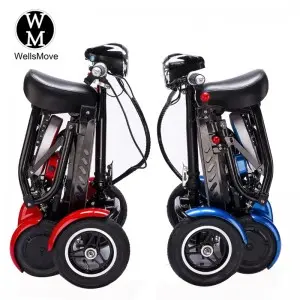When choosing a mobility scooter, one of the key decisions to make is whether to choose an all-wheel or four-wheel model. Both options have their own advantages and disadvantages, and the final decision depends on the user’s specific needs and preferences. In this article, we’ll explore the differences between all-wheel and four-wheel mobility scooters to help you make an informed decision.
First, let’s take a closer look at four-wheel mobility scooters. These scooters are designed keeping in mind stability and maneuverability. The four-wheel configuration provides a wider, more stable base, making it ideal for outdoor use and rough terrain. This extra stability is especially beneficial for people who have difficulty maintaining balance while driving or who need extra support.
Additionally, four-wheel mobility scooters generally provide a smoother ride, especially on uneven surfaces. The four-wheel design distributes the weight of the scooter more evenly, reducing the impact of bumps and obstacles in the user’s path. This can make outdoor activities such as shopping or sightseeing more enjoyable and comfortable for users.
All-wheel mobility scooters, on the other hand, are designed to provide enhanced traction and performance, especially on challenging surfaces such as gravel, grass, or steep slopes. The all-wheel drive system ensures power is distributed to all wheels, allowing the scooter to maintain traction and stability in a variety of conditions. This is especially beneficial for people who live an active lifestyle and need a scooter that can handle all types of terrain.
In terms of mobility, four-wheel scooters are generally more nimble and easier to navigate in tight spaces. The small turning radius of a four-wheel scooter makes it ideal for indoor use, such as passing through doorways or maneuvering in crowded spaces. This can be a significant advantage for individuals who use their scooters primarily indoors or in areas with limited space.
In contrast, all-wheel mobility scooters may have a larger turning radius due to their enhanced traction and stability characteristics. While they perform well in outdoor settings, they may not be as flexible in limited spaces. Therefore, people who primarily need to use their scooters outdoors may find an all-wheel model better suited to their needs.
When considering the comfort and support offered by each type of scooter, it’s important to note that both four-wheel and all-wheel models offer a range of seating options and suspension systems to suit different preferences. Factors such as seat size, cushioning and adjustability should be considered when evaluating the overall comfort of a mobility scooter.
Another important consideration is the scooter’s battery life and driving range. Both four-wheel and all-wheel models are available in different battery capacities, and the user’s specific needs will determine which option is more suitable. Individuals who need a scooter for longer trips or extended use may benefit from a model with a longer battery life, regardless of wheel configuration.
Ultimately, choosing an all-wheel or four-wheel mobility scooter comes down to one’s lifestyle, mobility needs, and personal preferences. When making this decision, it’s important to consider factors such as intended use, terrain, maneuverability, comfort, and battery life.
In conclusion, both all-wheel and four-wheel scooters have unique benefits and features that can meet the needs of different users. The choice between the two ultimately comes down to an individual’s specific needs and preferences. By carefully evaluating the pros and cons of each type of scooter, users can make an informed decision that best suits their mobility needs and improves their overall quality of life.
Post time: May-31-2024



